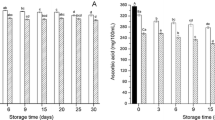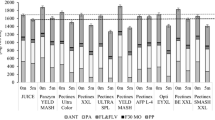Abstract
Juices were obtained on pilot-plant scale from untreated, steamed and peeled pomegranate fruits (Punica granatum L.), respectively, by applying increasing pressures and various juice treatments, i.e., enzymatic treatment, filtration, clarification and pasteurization, to determine the influence of process technology on the phenolic profiles and contents of the juices. Polyphenols were characterized and quantified by HPLC-DAD-ESI/MSn, and total phenolics and antioxidant capacity of the juices were determined by Folin–Ciocalteu, FRAP and TEAC assays, respectively. The total amounts of anthocyanins and colorless phenolics in the juices significantly differed depending on the applied technology. Highest phenolic recoveries were obtained from steamed fruits without further treatment. In contrast, lowest phenolic contents were determined in the juices produced from peeled fruits, i.e., the isolated seeds with adherent arils. With increasing pressures, polyphenol recoveries were enhanced, whereas juice treatments such as microfiltration and fining lowered phenolic contents of the juices. Furthermore, the amounts of individual phenolics were determined by HPLC-DAD with ellagitannins dominating the phenolic profiles. Juices solely produced from the edible parts of pomegranate exhibited lower amounts of ellagitannins compared with the juices from entire fruits. In contrast, the former juices were characterized by the highest amounts of gallotannins, hydroxybenzoic acids, hydroxycinnamic acids and dihydroflavonols. These results were consistent with the astringency of the juices. Additionally, storage experiments were performed at 4 °C and 20 °C in the dark and 20 °C under light exposure, revealing significant pigment degradation and concomitant color loss, especially at elevated temperatures and upon illumination, whereas the contents of non-anthocyanin phenolics and antioxidant capacity remained virtually unchanged throughout storage.







Similar content being viewed by others
References
Viuda-Martos M, Fernandez-Lopez J, Perez-Alvarez JA (2010) Pomegranate and its many functional components as related to human health. Compr Rev Food Sci Food Saf 9:635–654
USDA Agricultural Research Service, Nutrient Data Laboratory (2010) USDA database for oxygen radical absorbance capacity (ORAC) of selected foods. Release 2
Seeram NP, Aviram M, Zhang Y, Henning SM, Feng L, Dreher M, Heber D (2008) Comparison of antioxidant potency of commonly consumed polyphenol-rich beverages in the United States. J Agric Food Chem 56:1415–1422
Wittenauer J, Falk S, Schweiggert U, Carle R (2011) Characterisation and quantification of xanthones from the aril and pericarp of mangosteens (Garcinia mangostana L.) and a mangosteen containing functional beverage by HPLC-DAD-MSn. Food Chem (submitted)
Jurenka J (2008) Therapeutic applications of pomegranate (Punica granatum L.): a review. Altern Med Rev 13:128–144
Miguel MG, Neves MA, Antunes MD (2010) Pomegranate (Punica granatum L.): a medicinical plant with myriad biological properties—a short review. J Med Plant Res 4:2836–2847
Yildiz H, Obuz E, Bayraktaroglu G (2009) Pomegranate: its andioxidant acitvity and its effect on health. Acta Hortic 818:265–270
Dinnella C, Recchia A, Tuorila H, Monteleone E (2011) Individual astringency responsiveness affects the acceptance of phenol-rich foods. Appetite 56:633–642
Fischer UA, Carle R, Kammerer DR (2011) Identification and quantification of phenolic compounds from pomegranate (Punica granatum L.) peel, mesocarp, aril and differently produced juices by HPLC-DAD-ESI/MSn. Food Chem 127:807–821
Kammerer D, Gajdos Kljusuric J, Carle R, Schieber A (2005) Recovery of anthocyanins from grape pomace extracts (Vitis vinifera L. cv. Cabernet Mitos) using a polymeric adsorber resin. Eur Food Res Technol 220:431–437
Moßhammer MR, Stinzing FC, Carle R (2005) Development of a process for the production of a betalain-based colouring foodstuff from cactus pear. Innov Food Sci Emerg Technol 6:221–231
Chandra A, Rana J, Li Y (2001) Separation, identification, quantification, and method validation of anthocyanins in botanical supplement raw materials by HPLC and HPLC-MS. J Agric Food Chem 49:3515–3521
Benzie IF, Strain JJ (1996) The ferric reducing ability of plasma (FRAP) as a measure of antioxidant power: the FRAP assay. Anal Biochem 239:70–76
van den Berg R, Haenen GRMM, van den Berg H, Bast A (1999) Applicability of an improved trolox equivalent antioxidant capacity (TEAC) assay for evaluation of antioxidant capacity measurements of mixtures. Food Chem 66:511–517
Singleton VL, Orthofer R, Lamuela-Raventós RM (1999) Analysis of total phenols and other oxidation substrates and antioxidants by means of Folin-Ciocalteu reagent. Methods Enzymol 299:152–178
Busch-Stockfisch M (2002) Praxishandbuch Sensorik in der Produktentwicklung und Qualitätssicherung. Behr`s Verlag, Hamburg
DIN 10963 (1997) Sensorische Prüfverfahren; Rangordnungsprüfung. Beuth Verlag GmbH, Berlin
Maskan M (2006) Production of pomegranate (Punica granatum L.) juice concentrate by various heating methods: colour degradation and kinetics. J Food Eng 72:218–224
Ozmiański J, Wojdylo A (2007) Effects of various clarification treatments on phenolic compounds and color of apple juice. Eur Food Res Technol 224:755–762
Patras A, Brunton AP, O’Donnel C, Tiwari BK (2010) Effect of thermal processing on anthocyanin stability in foods; mechanisms and kinetics of degradation. Trends Food Sci Technol 21:3–11
Sadilova E, Stintzing FC, Kammerer DR, Carle R (2009) Matrix dependent impact of sugar and ascorbic acid addition on color and anthocyanin stability of black carrot, elderberry single strength and from concentrate juices upon thermal treatment. Food Res Int 42:1023–1033
Sadilova E, Carle R, Stintzing FC (2007) Thermal degradation of anthocyanins and its impact on color and in vitro antioxidant capacity. Mol Nutr Food Res 51:1461–1471
Tanaka T, Nonaka GI, Nishika I (1986) Tannins and related compounds. XLI. Isolation and characterization of novel ellagitannins, punicacorteins A, B, C and D, and punigluconin from the bark of Punica granatum L. Chem Pharm Bull 34:656–663
Zywicki B, Reemtsma T, Jekel M (2002) Analysis of commercial vegetable tanning agents by reversed-phase liquid chromatography electrospray ionization-tandem mass spectrometry and its application to wastewater. J Chromatogr A 970:191–200
Moran JF, Klucas RV, Grayer RJ, Abian J, Harborne JB, Becana M (1998) Characterization of phenolic glucosides from soybean root nodules by ion-exchange high performance liquid chromatography, ultraviolet spectroscopy and electrospray mass spectrometry. Phytochem Anal 9:171–176
Slimestad R, Andersen OM, Francis GW, Marston A, Hostettmann K (1995) Syringetin 3-O-(6”-acetyl)-β-glucopyranoside and other flavonols from needles of Norway spruce, Picea abies. Phytochemistry 40:1537–1542
Alper N, Bahceci KS, Acar J (2004) Effect of various ultrafiltration treatments on some quality parameters of pomegranate juice. Fruit Process 1:33–37
Mirsaeedghazi H, Emam-Djomeh Z, Mohammad Mousavi S, Ahmadkhaniha R, Shafiee A (2010) Effect of membrane clarification on the physicochemical properties of pomegranate juice. Int J Food Sci Technol 45:1457–1463
Alper N, Acar J (2004) Removal of phenolic compounds in pomegranate juices using ultrafiltration and laccase-ultrafiltration combinations. Food 48:184–187
Onsekizoglu P (2010) Clarification and the concentration of apple juice using membrane processes: a comparative quality assessment. J Membr Sci 352:160–165
Brownmiller C (2008) Processing and storage effects on monomeric anthocyanins, percent polymeric color, and antioxidant capacity of processed blueberry products. J Food Sci 73:272–279
Pérez-Vicente A, Serrano P, Abellán P, Garcia-Viguera C (2004) Influence of packaging material on pomegranate juice colour and bioactive compounds, during storage. J Sci Food Agric 84:639–644
Hager A, Howard LR, Prior RL, Brownmiller C (2008) Processing and storage effects on monomeric anthocyanins, percent polymeric color and antioxidant capacity of processed black raspberry products. J Food Sci 73:134–140
Gil MI, Tomás-Barberán FA, Hess-Pierce B, Holcroft DM, Kader AA (2000) Antioxidant activity of pomegranate juice and its relationship with phenolic composition and processing. J Agric Food Chem 48:4581–4589
Vardin H, Fenercioğlu H (2009) Study on the development of pomegranate juice processing technology; the pressing of pomegranate fruit. Acta Hort 818:373–381
Li Y, Guo C, Yang J, Wei J, Xu J, Cheng S (2006) Evaluation of antioxidant properties of pomegranate peel extract in comparison with pomegranate pulp extract. Food Chem 96:254–260
Martin KR, Krueger CG, Rodriquez G, Dreher M, Reed JD (2009) Development of a novel pomegranate standard and new method for the quantitative measurement of pomegranate polyphenols. J Sci Food Agric 89:157–162
Schwartz E, Tzulker R, Glazer I, Bar-Ya’akov I, Wiesman Z, Tripler E, Bar-Ilan I, Fromm H, Borochov-Neori H, Holland D, Amir R (2009) Environmental conditions affect the color, taste, and antioxidant capacity of 11 pomegranate accessions fruits. J Agric Food Chem 113:736–747
Li ZF, Sawamura M, Kusunose H (1988) Rapid determination of furfural and 5-hydroxymethylfurfural in processed citrus juices by HPLC. Agric Biol Chem 52:2231–2234
Poretta S, Sandei L (1991) Determination of 5-(hydroxymethyl)-2-furfural (HMF) in tomato products: proposal of a rapid HPLC method and its comparison with the colorimetric method. Food Chem 39:51–57
Vardin H, Fenercioğlu H (2003) Study on the development of pomegranate juice processing technology: clarification of pomegranate juice. Food 47:300–303
Alper N, Bahceci KS, Acar J (2005) Influence of processing and pasteurization on color values and total phenolic compounds of pomegranate juice. J Food Process Preserv 29:357–368
Kader F, Irmouli M, Nicolas JP, Metche M (1999) Degradation of cyanidin by caffeic acid o-quinone. Determination stoichiometry and characterization of degraded products. J Agric Food Chem 47:4625–4630
Gil MI, Cherif J, Ayed N, Artés F, Tomás-Barberán FA (1995) Influence of cultivar, maturity stage and geographical location on the juice pigmentation of Tunisian pomegranates. Z Lebensm Unters Forsch 201:361–364
Miguel G, Fontes C, Antunes D, Neves A, Martins D (2004) Anthocyanin concentration of “Assaria” pomegranate fruits during different cold storage conditions. J Biomed Biotechnol 5:338–342
Gil MI, Garcia-Viguera C, Artés F, Tomás-Barberán FA (1995) Changes in pomegranate juice pigmentation during ripening. J Sci Food Agric 68:77–81
Lee CB, Lawless HT (1991) Time-course of astringent materials. Chem Senses 16:225–238
Stintzing FC, Carle R (2004) Functional properties of anthocyanins and betalains in plants, food, and in human nutrition. Trends Food Sci Technol 15:19–38
Alighourchi H, Barzegar M, Abbasi S (2007) Anthocyanins characterization of 15 Iranian pomegranate (Punica granatum L.) varieties and their variation after cold storage and pasteurization. Eur Food Res Technol 227:881–887
Kirca A, Özkan M, Cemeroğlu B (2007) Effects of temperature, solid content and pH on the stability of black carrot anthocyanins. Food Chem 101:212–218
Skrede G, Wrolstad RE, Durst RW (2000) Changes in anthocyanins and polyphenolics during juice processing of highbush blueberries (Vaccinium corymbosum L.). J Food Sci 65:357–364
Alighourchi H, Barzegar M (2009) Some physicochemical characteristics and degradation kinetic of anthocyanin of reconstituted pomegranate juice during storage. J Food Eng 90:179–185
Reed JD, Krueger CG, Vestling MM (2005) MALDI-TOF mass spectrometry of oligomeric food polyphenols. Phytochemistry 66:2248–2263
Marti N, Pérez-Vicente A, Garcia-Viguera C (2001) Influence of storage temperature and ascorbic acid addition on pomegranate juice. J Sci Food Agric 82:217–221
Gonnet J (1998) Colour effects of co-pigmentation of anthocyanins revisited—1. A colorimetric definition using the CIELAB scale. Food Chem 63:409–415
Maier T, Fromm M, Schieber A, Kammerer DR, Carle R (2009) Process and storage stability of anthocyanins and non-anthocyanin phenolics in pectin and gelatin gels enriched with grape pomace extracts. Eur Food Res Technol 229:949–960
Wang H, Cao G, Prior RL (1996) Total antioxidant capacity of fruits. J Agric Food Chem 44:701–705
Acknowledgments
One of the authors (U.A.F.) gratefully acknowledges a scholarship of the endowment fund UNILEVER by the Association for the Promotion of Science and Humanities in Germany, Essen, Germany. We thank Klaus Mix and Erika Müssig for their excellent assistance in pilot-plant and laboratory experiments, respectively.
Author information
Authors and Affiliations
Corresponding author
Rights and permissions
About this article
Cite this article
Fischer, U.A., Dettmann, J.S., Carle, R. et al. Impact of processing and storage on the phenolic profiles and contents of pomegranate (Punica granatum L.) juices. Eur Food Res Technol 233, 797–816 (2011). https://doi.org/10.1007/s00217-011-1560-3
Received:
Revised:
Accepted:
Published:
Issue Date:
DOI: https://doi.org/10.1007/s00217-011-1560-3




